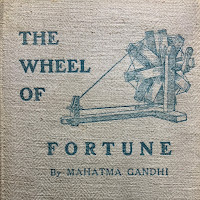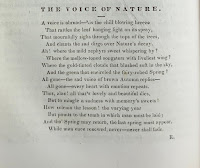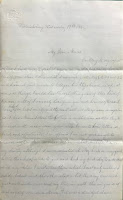Both “The Voice of Nature” and William Cullen Bryant’s “Thanatopsis” present models for understanding the inescapability of death – that every man will enter “the great tomb of man” (Bryant) “in which man must be laid” (
). But the poems differ in their response to the inevitable – where “The Voice of Nature” responds to death with the hope of the resurrection: “man once renewed never – never shall fade,” “Thanatopsis” restates that man will always remain dead in “thine eternal resting-place,” “in their last sleep,” and “each shall take / His chamber in the silent halls of death.” By implication, “The Voice of Nature” invokes a more Judeo-Christian model of death’s impermanence and the promise of renewal, whereas “Thanatopsis” responds with a more stoic approach to death’s permanence: “So live… by an unfaltering trust” and “approach thy grave.”
By effect, both “The Voice of Nature” and “Thanatopsis” build the emotional stake within the poem in order to respond to a more realized feeling: the build – “all that's lovely and beautiful dies” (The Dartmouth) and “So shalt thou rest… all that breath will share thy destiny” (Bryant); and the response – “man once renewed never – never shall fade” (The Dartmouth) and “So live” (Bryant). Even though “Thanatopsis” and “The Voice of Nature” were published within twenty-three years of each other and focus on similar themes, each presents a unique response to death’s authority and by their distinctions could illustrate fashionable divisions and conceptions of the afterlife in the early nineteenth-century.
Yet not to thine eternal resting-place
Shalt thou retire alone, nor couldst thou wish
Couch more magnificent. Thou shalt lie down
With patriarchs of the infant world—with kings,
The powerful of the earth—the wise, the good,
Fair forms, and hoary seers of ages past,
All in one mighty sepulchre. The hills
Rock-ribbed and ancient as the sun,—the vales
Stretching in pensive quietness between;
The venerable woods—rivers that move
In majesty, and the complaining brooks
That make the meadows green; and, poured round all,
Old Ocean’s gray and melancholy waste,—
Are but the solemn decorations all
Of the great tomb of man. The golden sun,
The planets, all the infinite host of heaven,
Are shining on the sad abodes of death,
Through the still lapse of ages. All that tread
The globe are but a handful to the tribes
That slumber in its bosom.—Take the wings
Of morning, pierce the Barcan wilderness,
Or lose thyself in the continuous woods
Where rolls the Oregon, and hears no sound,
Save his own dashings—yet the dead are there:
And millions in those solitudes, since first
The flight of years began, have laid them down
In their last sleep—the dead reign there alone.
So shalt thou rest, and what if thou withdraw
In silence from the living, and no friend
Take note of thy departure? All that breathe
Will share thy destiny. The gay will laugh
When thou art gone, the solemn brood of care
Plod on, and each one as before will chase
His favorite phantom; yet all these shall leave
Their mirth and their employments, and shall come
And make their bed with thee. As the long train
Of ages glide away, the sons of men,
The youth in life’s green spring, and he who goes
In the full strength of years, matron and maid,
The speechless babe, and the gray-headed man—
Shall one by one be gathered to thy side,
By those, who in their turn shall follow them.
So live, that when thy summons comes to join
The innumerable caravan, which moves
To that mysterious realm, where each shall take
His chamber in the silent halls of death,
Thou go not, like the quarry-slave at night,
Scourged to his dungeon, but, sustained and soothed
By an unfaltering trust, approach thy grave,
Like one who wraps the drapery of his couch
About him, and lies down to pleasant dreams.
 To start our Halloween weekend off right, we're taking a look at Varney the Vampyre; or, The Feast of Blood, an early example of European vampire literature in a deliciously pulpy format. Variously attributed to James Malcolm Rymer or Thomas Peckett Prest, Varney was published as a series of cheaply printed pamphlets from 1845 to 1847. This "penny dreadful" style of printing was inexpensive, popular, and typically followed sensational stories of mystery, romance, and horror.
To start our Halloween weekend off right, we're taking a look at Varney the Vampyre; or, The Feast of Blood, an early example of European vampire literature in a deliciously pulpy format. Variously attributed to James Malcolm Rymer or Thomas Peckett Prest, Varney was published as a series of cheaply printed pamphlets from 1845 to 1847. This "penny dreadful" style of printing was inexpensive, popular, and typically followed sensational stories of mystery, romance, and horror.



































